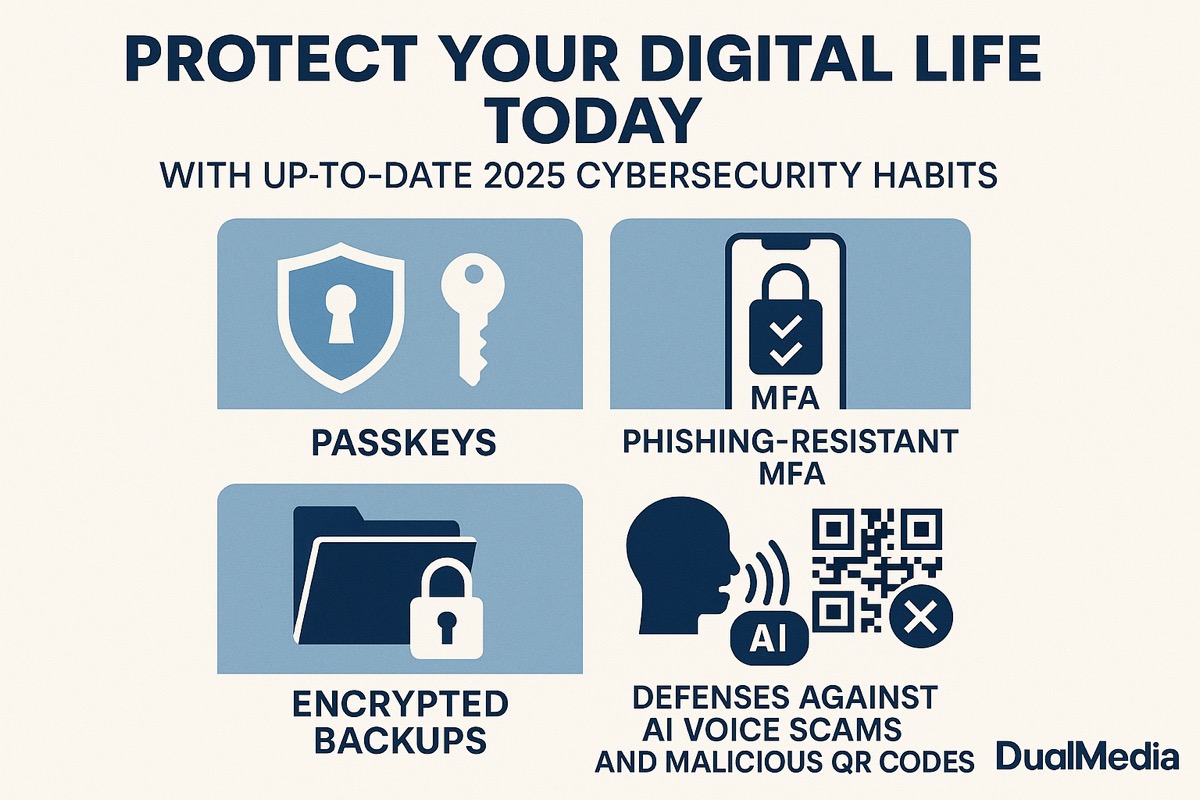Protect your digital life today with up-to-date 2025 cybersecurity habits with DualMedia —passkeys, phishing-resistant MFA, encrypted backups, and defenses against AI voice scams and malicious QR codes.
Do you actually have a 2025-ready security routine?
Cyber threats have leveled up: targeted phishing, AI voice deepfakes, booby-trapped QR codes, SIM-swap account takeovers. The first line of defense is you. The good news: a handful of simple habits drastically cuts risk. In this DualMedia Innovation News guide, we focus on high-impact moves you can set and forget—turn on the right settings, automate updates, and adopt modern authentication like passkeys to lock down your most important accounts.
The 2025 Top 10 at a glance
| High-impact move | Why it matters now | How to do it fast |
|---|---|---|
| Passkeys & phishing-resistant MFA | Passwords get stolen; passkeys don’t reuse secrets across sites | Turn on “Passkeys”/“Security keys” on email, banking, socials. Add a FIDO2 key for admin/bank. |
| Password manager | One unique, random password per site without memorizing | Pick a reputable manager. Enable biometric unlock and breach alerts. |
| Auto-updates everywhere | Patches close widely exploited holes | Enable auto-update for OS, browser, plugins, apps, router. Reboot weekly. |
| Hardened browser | Your #1 attack surface | Separate work/personal profiles, HTTPS-only, tracker blocking, site isolation, minimal extensions. |
| 3-2-1 encrypted backups | Ransomware and device loss happen | 3 copies, 2 media, 1 off-site (cloud or offline). Test a restore each quarter. |
| Strong home Wi-Fi | Many breaches start at the router | WPA3, long passphrase, firmware up to date, disable WPS & remote admin, separate guest SSID. |
| Lock down the phone | Your identity and finances live here | Long passcode/biometric, “Find My” + remote wipe, strict app permissions, official app stores only. |
| Phishing & QR discipline | Social engineering bypasses tech | Don’t click from emails/SMS. Type the URL yourself. Be wary of public QR codes. |
| Shrink your data footprint | Less exposed data = less damage | Tighten social privacy, remove from data brokers, limit recovery options to essentials. |
| Personal incident plan | Speed is everything during a breach | Keep an offline checklist: critical accounts, recovery methods, bank/carrier numbers, steps after phone theft. |
1) Move to passkeys and real phishing-resistant MFA
Passkeys and FIDO2 security keys are the strongest defense against account takeovers—far safer than SMS codes. Prioritize your “root” accounts first: primary email, bank, password manager, cloud storage, admin-level social accounts. Add at least two recovery methods and confirm your recovery numbers/emails so you don’t lock yourself out.
2) Unique passwords with a manager—or bust
For services that don’t support passkeys yet, you still need one unique, random password per site. A password manager generates and fills long, unpredictable passwords, monitors known breaches, and flags reuse. Turn on end-to-end encrypted sync and biometric unlock. Consider disabling autofill on unknown pages to avoid poisoned forms.
3) Automate updates for OS, browser, and apps
Most mass attacks target already-patched flaws. Enable silent updates for your OS, browser, extensions, runtimes, office suite—and your router. On mobile, allow automatic app updates. Reboot regularly so kernel/firmware fixes actually apply.
4) Browse with guardrails and clean profiles
Treat your browser like your main workstation. Separate profiles for work and personal logins. Enable HTTPS-Only, auto-clear third-party cookies on close, and site isolation if available. Uninstall unnecessary extensions. For suspicious attachments, open in a cloud viewer or sandbox—not your main device.

5) 3-2-1 encrypted backups with quarterly restore tests
A backup you’ve never restored is a gamble. Follow 3-2-1: three copies, two different media, one off-site (cloud or offline). Schedule daily incremental backups for critical folders and test a restore every quarter. Keep at least one immutable/locked version to blunt ransomware.
6) Take your home network seriously
Change the router’s default admin credentials, update firmware, and disable WPS and remote administration. Use WPA3 (or WPA2-AES if you must). Put guests and IoT on a separate SSID. On smart devices, turn off unneeded features, update when available, and avoid access to your primary network.
7) Turn your smartphone into a vault
Use a long passcode or biometrics, confirm device encryption, and enable “Find My” plus remote wipe. Audit app permissions—flashlight apps don’t need your contacts. Avoid sideloaded APKs/profiles. In messengers, enable encrypted backups and lock sensitive chats.
8) Outsmart modern phishing—including QR traps
Phishing has moved to SMS, messaging apps, and QR codes. Don’t click links from unsolicited messages—even if they seem to be from a known brand or “support.” Type the address yourself, verify the domain, and look for secure sign-in indicators. Be skeptical of urgent requests, unexpected attachments, and QR codes slapped on public signage or meters.
9) Reduce your public data footprint
Less public data means less ammo for attackers. Limit birthday, address, and family details on social media. Opt out of data brokers where possible, and consider a credit freeze if your country supports it. Keep account recovery options lean and up to date, and add trusted contacts only where necessary.
10) Build a one-page personal incident plan
Write an offline checklist: which accounts to secure first, how to reset passwords and revoke sessions, bank and carrier hotlines, and your steps for a lost or stolen phone. In a theft scenario: lock/wipe the phone, change your primary email password, revoke active sessions and app tokens, then re-enable MFA.
Bottom line
Effective cybersecurity is a routine, not a shopping list. Switch to passkeys, harden your browser and Wi-Fi, automate updates, keep real encrypted backups, and practice saying “no” to unexpected links and QR codes. Got a specific setup, incident, or “is this legit?” screenshot? Drop it in the comments—DualMedia Innovation News will help and keep this guide current.


